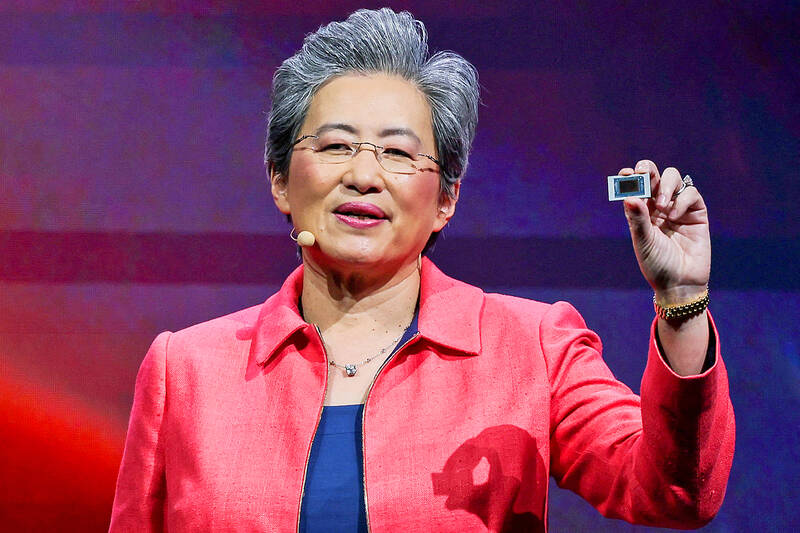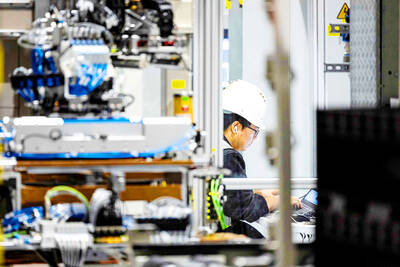Advanced Micro Devices Inc (AMD) suffered its biggest stock decline in more than a month after the company unveiled new artificial intelligence (AI) chips, but did not provide hoped-for information on customers or financial performance.
The stock slid 4 percent to US$164.18 on Thursday, the biggest single-day drop since Sept. 3. Shares of the company remain up 11 percent this year.
AMD has emerged as the biggest contender to Nvidia Corp in the lucrative market of AI processors. The company’s latest chips would exceed some capabilities of its rival, AMD chief executive officer Lisa Su (蘇姿丰) said at an event hosted by the company in San Francisco on Thursday,

Photo: Ann Wang, Reuters
Computer systems based on AMD’s MI325X processors would be available soon and have an edge over machines running Nvidia’s H100, she said, adding that the MI325X’s use of a new type of memory chip would give it better performance at running AI software — a process known as inference.
“This is an incredibly fast-growing market,” Su said during an interview with Bloomberg Television’s Ed Ludlow.
“We view this as a multiyear opportunity,” she added.
The Santa Clara, California-based company is trying to crack Nvidia’s dominance in so-called AI accelerators — chips that have become essential to the development of AI systems. Like Nvidia, AMD has committed to releasing new accelerators every year, stepping up its pace of innovation.
Under Su, the company has eclipsed its longtime rival Intel Corp in market valuation. However, both companies were caught off guard by how ferociously the industry embraced AI accelerators.
Of the two, AMD has responded far more quickly and established itself as the closest rival to Nvidia. AMD has set a target of US$4.5 billion of revenue from the new type of chips for this year, a rapid increase.
Su has said the overall market for such chips would hit US$400 billion in 2027. On Thursday, she said that the company expects that number to reach US$500 billion in 2028.
At the event, Su also said the company is releasing a new line of server processors based on its “Turin” technology, making a fresh push into a market once dominated by Intel.
Computers are going on sale with AMD’s fifth-generation EPYC central processing units, she said, adding that the chips have as many as 192 processor cores and can outperform the latest Intel products.
The company said that it now has 34 percent of the market for this category of chips when measured by revenue. Although Intel still dominates the segment, it once had a 99 percent share.
Su said that she expects continued growth in demand for AI and that the industry is still “just getting started” in its use of the new technology.
Separately, Su said AMD has no current plans to change the suppliers it uses for cutting-edge manufacturing. However, the company wants more geographical diversity in terms of its production, and is looking to work with Taiwan Semiconductor Manufacturing Co’s (台積電) new Arizona facility. Su refused to rule out using either Samsung Electronics Co or Intel in the future. She said AMD is keeping an open mind.
“We’re always looking at the manufacturing landscape and will always think about how we can have the most resilient supply chain,” she said.

CHIP RACE: Three years of overbroad export controls drove foreign competitors to pursue their own AI chips, and ‘cost US taxpayers billions of dollars,’ Nvidia said China has figured out the US strategy for allowing it to buy Nvidia Corp’s H200s and is rejecting the artificial intelligence (AI) chip in favor of domestically developed semiconductors, White House AI adviser David Sacks said, citing news reports. US President Donald Trump on Monday said that he would allow shipments of Nvidia’s H200 chips to China, part of an administration effort backed by Sacks to challenge Chinese tech champions such as Huawei Technologies Co (華為) by bringing US competition to their home market. On Friday, Sacks signaled that he was uncertain about whether that approach would work. “They’re rejecting our chips,” Sacks

It is challenging to build infrastructure in much of Europe. Constrained budgets and polarized politics tend to undermine long-term projects, forcing officials to react to emergencies rather than plan for the future. Not in Austria. Today, the country is to officially open its Koralmbahn tunnel, the 5.9 billion euro (US$6.9 billion) centerpiece of a groundbreaking new railway that will eventually run from Poland’s Baltic coast to the Adriatic Sea, transforming travel within Austria and positioning the Alpine nation at the forefront of logistics in Europe. “It is Austria’s biggest socio-economic experiment in over a century,” said Eric Kirschner, an economist at Graz-based Joanneum

BUBBLE? Only a handful of companies are seeing rapid revenue growth and higher valuations, and it is not enough to call the AI trend a transformation, an analyst said Artificial intelligence (AI) is entering a more challenging phase next year as companies move beyond experimentation and begin demanding clear financial returns from a technology that has delivered big gains to only a small group of early adopters, PricewaterhouseCoopers (PwC) Taiwan said yesterday. Most organizations have been able to justify AI investments through cost recovery or modest efficiency gains, but few have achieved meaningful revenue growth or long-term competitive advantage, the consultancy said in its 2026 AI Business Predictions report. This growing performance gap is forcing executives to reconsider how AI is deployed across their organizations, it said. “Many companies

France is developing domestic production of electric vehicle (EV) batteries with an eye on industrial independence, but Asian experts are proving key in launching operations. In the Verkor factory outside the northern city of Dunkirk, which was inaugurated on Thursday, foreign specialists, notably from South Korea and Malaysia, are training the local staff. Verkor is the third battery gigafactory to open in northern France in a region that has become known as “Battery Valley.” At the Automotive Energy Supply Corp (AESC) factory near the city of Douai, where production has been under way for several months, Chinese engineers and technicians supervise French recruits. “They